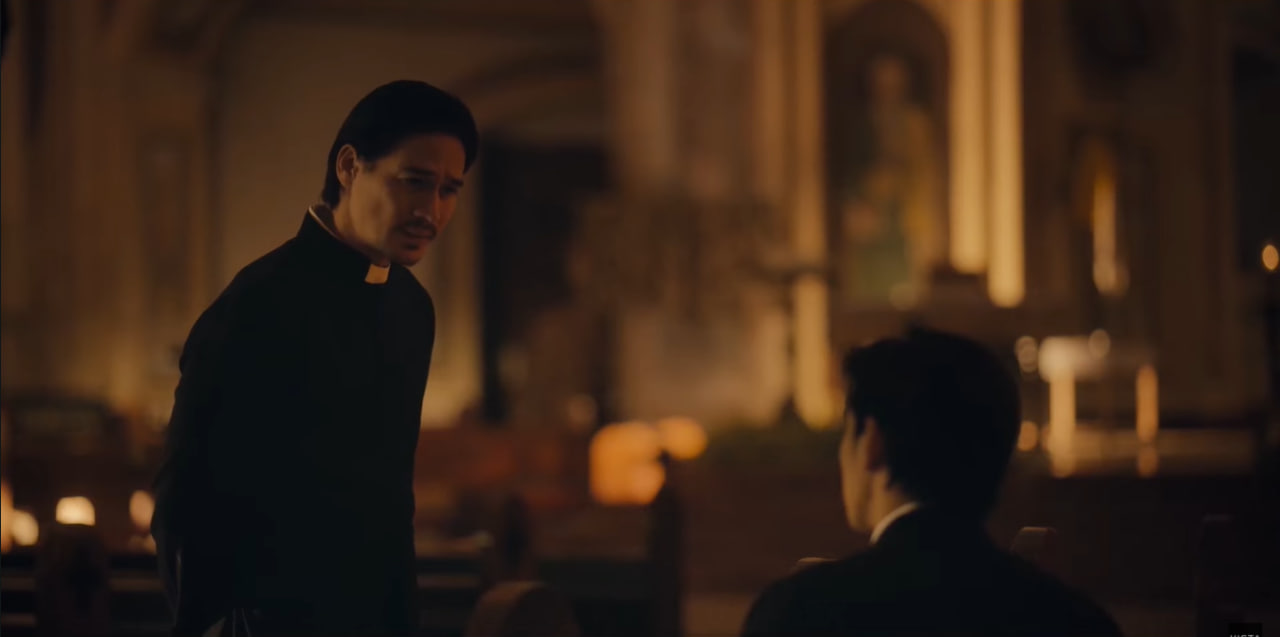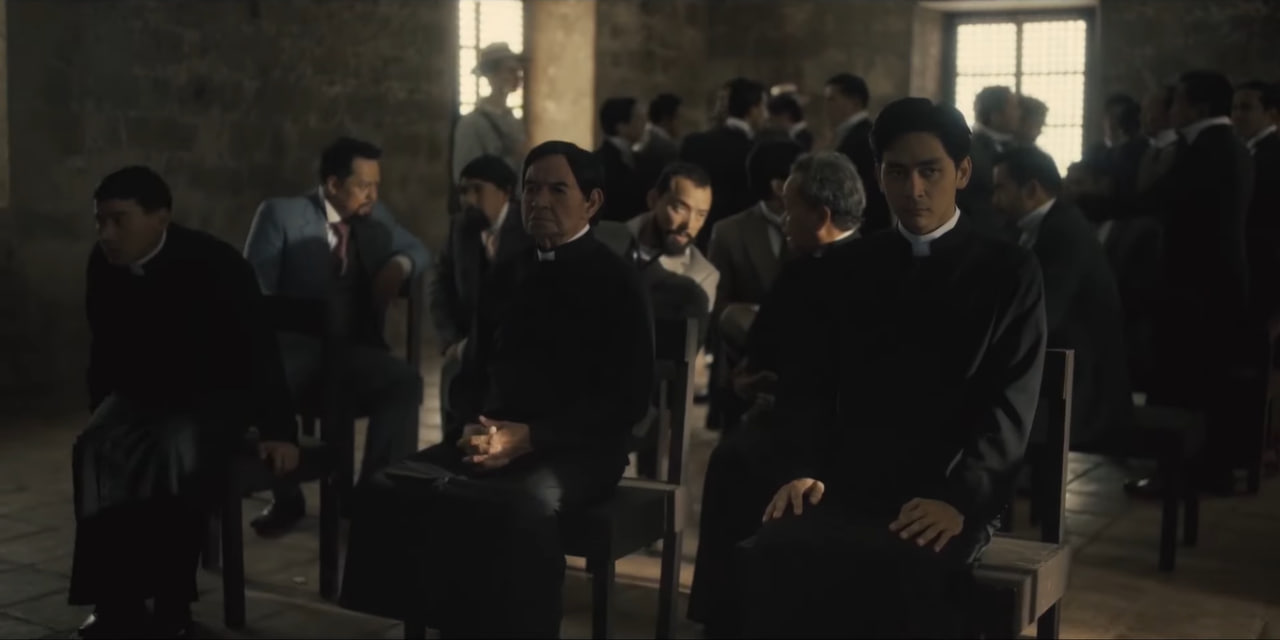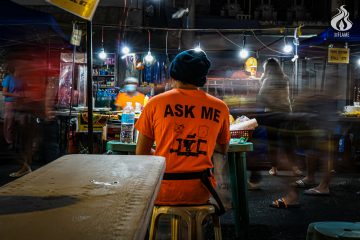
The film GomBurZa transports the audiences to the year 1872 to retell the tale of the three martyr priests whose deaths marked the start of a slowly but surely prospering nationalist consciousness.
Directed by Pepe Diokno and based on stories by Filipino Jesuit historian John Schumacher, GomBurZa is based on real-life events said to have inspired national hero José Rizal to resist the Spanish colonial rule.
Draped in an immersive cinematic encounter and enriched with narration and captivating computer-generated imagery or CGI reenactments, the initial scenes bore a resemblance to a live stage theatre, albeit with a somewhat lackluster translation onto the grandeur of the big screen. However, the film’s prospects took a turn for the better, courtesy of the vibrant props and the compelling voice performance of Padre Pelaez (Piolo Pascual). As he skillfully guided the narrative introduction, the focus seamlessly shifted from the historical reenactment of Hermano Pule’s tale to a poignant scene featuring Padre Pelaez, Padre Gomes (Dante Rivero) and the then-student José Burgos (Cedrick Juan) sharing a meal.
About a quarter of the film consisted of scenes that showed Padre Pelaez attempting to resist the manifesto ordering the transfer of Cavite and Antipolo dioceses to the Spanish friars, which he thought to be unfair towards secular priests. Although Pelaez was a Spaniard in speech and blood, the friars did not treat him as their own.
For casual movie enthusiasts, following the execution of Spanish dialogue might be perplexing, leaving the audience to decipher it on their own. The film assumed a level of knowledge among its audience. This raises concerns for those unfamiliar with Philippine history.
Still, the film excelled in the reenactment of past events, particularly in its meticulous set design and costumes that served as a visual primer on the history of the GomBurZa for those who may need to be better versed in the subject.

The unexpected demise of Padre Pelaez had a profound impact on Padre Burgos. Regarded as an esteemed and educated priest, Burgos, in his role as a teacher, advocated for his students to express themselves in both Spanish and Filipino — languages they felt at ease with. As Pelaez posthumously faced accusations of disrespect and betrayal to the Spanish government, Burgos vividly recalled the cautionary words he had once shared with him. Warned that if he dared to champion the rights of secular priests, he might one day be branded a filibustero, Burgos grappled with the implications of his own position within the church hierarchy.
Since the film centered on Padre Burgos’s life, the audience could see his evolution as a law student, priest, liberalist, reformist and human. The viewers can recognize his thoughts and feelings, thanks to Juans’s performance as Padre Burgos. Juan’s ability to express his character’s emotions without the need for certain dialogues is very impressive, making him deserving of the Best Actor award.
The film showcased the history of the Cavite Mutiny with its impeccable storytelling. A scene involved Padre Zamora (Enchong Dee) being unjustly thrown into a cell alongside Padre Gomes and Padre Burgos. At a time when persecution loomed over secular priests advocating for equality, Zamora found himself accused merely for being present where tensions were rising. Although he played a minimal role in the overall narrative, his inclusion may raise questions among those who are unfamiliar with him in the first place.
As courtroom “justice” further unfolded, Filipinos fighting for their compatriots were abandoned, fueled by an informant who accused one of the priests of orchestrating everything on behalf of the Spanish government.

The allegations were made despite Padre Burgos’ background as a law student and the valiant efforts of civilians despite the lack of evidence in their defense.
Although historical context can be quite an issue to some, the sequence of the story and dialogues throughout the film, like how it started from Padre Burgos’ life as a student of Padre Pelaez to the three priests’ execution, made it easier for the audience to grasp the nationalist ideas of the film.
Other than the storytelling and acting, the film’s cinematography was top-notch. The film’s color palette consisted of darker colors such as black, brown and red — almost not a vibrant color throughout the film, highlighting the film’s historical setting and ominous atmosphere. Most scenes were shot under dim lighting when the film reached its climax, indicating the start of doom.
The most striking aspect was the long duration of focus during Padre Burgos’ execution, which was both fierce and awe-inspiring. With only two colors present in the frame during the monumental part of his close-up execution, the tension present in the scene is sure to capture the audience’s attention and most importantly, Padre Burgos’ final moments.

Quite inevitably, the film had its flaws. The film could not tell much about the other priests, namely Padre Gomes and Padre Zamora. As stated earlier, the film focuses on Padre Burgos, giving the two other priests little screen time. Although Padre Burgos was often seen accompanied and guided by Padre Gomes, these scenes were the only times Padre Gomes was included in the narrative.
Meanwhile, although portrayed as one of the main characters, Padre Zamora was more like a minor character in the film. It was only during the capture of the priests that Padre Zamora was included in a significant scene. The presentation of Padre Gomes and Padre Zamora could have been enhanced, although time constraints or the deliberate focus on Padre Burgos should be considered.
While understanding the necessity for a streamlined narrative, there might have been a way to integrate Padre Zamora more effectively into the storyline, as GomBurZa was inherently complete with his convictions. Again, Padre Zamora’s prominence was confined mainly to his presence in the cell. Padre Gomes’ narrative primarily unfolded in the initial stages as he was older than Burgos and Zamora and may have had weaker physique as they strived for recognition as secular priests. It is worth noting that the film was conveyed with an intention of reenacting what motivated the revolution, centered on Padre Burgos’ perspective and selective in its portrayal of events.
Furthermore, the film powerfully illustrated the contrasting treatment of Spaniards raised in Spain and those raised in Manila, emphasizing a crucial question: are Filipinos valued for their shared identity, or are they empathized due to the broader struggles colonized peoples face?
Throughout the film, the camera focuses on affluent individuals, primarily aristocrats who can afford to educate their sons in Latin. Not present are depictions of impoverished Filipinos, serving only as background characters in roles like pastry servers and cigarette attendants. It encourages viewers to reflect on the film’s portrayal of societal dynamics and the potential omission of the struggles faced by the lower classes.
The film won the most accolades at the 49th Metro Manila Film Festival, including second best picture, best actor and best director among others.

GomBurZa was a contemplation of whether the death of the three priests catalyzed a revolutionary movement, particularly among Filipino students who ardently believed in the principles of liberalism.
Ultimately, the film is a reminder that the movement was not just out of personal interest but also for the Filipinos. GomBurZa opened and connected the audience to Philippine history and society by using its nationalist theme and showcasing the Filipino people’s grit and spirit to achieve a goal that benefits all Filipinos. F — J. M. Abdul and A. Y. Sacramento



